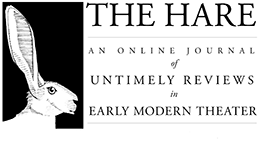Submitted by Anonymous (not verified) on
Our inaugural issue as coeditors of The Hare represents a new direction towards something old. Under the guidance of the journal’s co-founders, Jeremy Lopez and Paul Menzer, The Hare was created to feature brief, provocative essays and reviews of older scholarship, seeking to incite dialogue in that liminal space between copy-room conversation and thirty-five-page peer-reviewed publication. As incoming co-editors, we are reshaping The Hare’s mission to feature exclusively untimely reviews of “old” scholarship and performances–though we will now foster the untimely within the artistic community, as well, publishing future-looking pieces calling for unheard-of productions in early modern drama. We would like to express our deepest appreciation to Jeremy and Paul for creating such an outstanding forum for scholarly exchange.
This issue of the The Hare features untimely reviews of old scholarship and very old performances. Despite their formal differences, however, each of these reviews shares an investment in some version of the “collateral.” Jean Howard’s review of Richard Halpern’s The Poetics of Primitive Accumulation focuses on the potential this text still has to make us rethink literature’s relationship to the forms of collateral damage perpetrated on capitalism’s accumulated reserves of working bodies. Founding editors Jeremy Lopez and Paul Menzer each offer up the playful fantasy of in-period critical reviews of original early modern performances, focusing on collateral relations with audiences and characters. Lopez’s in-period review of John Fletcher’s The Faithfull Shepherdess laments the fact that its Blackfriars audience set this complex play aside, though its pastoral/allegorical mode is admittedly on the outer limits of fashionable theater at the time. Menzer’s review of Anthony Wadeson’s Look About You sighs with relief that Wadeson has finally achieved theatrical facility, through the character Red Cap’s running in place, co-lateral or side-by-side, with the main characters. Menzer suggests his stutter-stepping language renders Red Cap uniquely incapable of disguise and yet supremely imitable, in a play full of cloaked identities.
We are excited to publish such timely untimely reviews in early modern scholarship and performance, as each in their own way encourages us to continue to think anew the collateral effects of any regime of interpretation.
William Casey Caldwell
Amy Kenny
